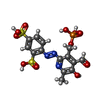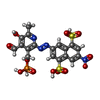+Search query
-Structure paper
| Title | Structural insights into the orthosteric inhibition of P2X receptors by non-ATP analog antagonists. |
|---|---|
| Journal, issue, pages | Elife, Vol. 12, Year 2024 |
| Publish date | Apr 5, 2024 |
 Authors Authors | Danqi Sheng / Chen-Xi Yue / Fei Jin / Yao Wang / Muneyoshi Ichikawa / Ye Yu / Chang-Run Guo / Motoyuki Hattori /  |
| PubMed Abstract | P2X receptors are extracellular ATP-gated ion channels that form homo- or heterotrimers and consist of seven subtypes. They are expressed in various tissues, including neuronal and nonneuronal cells, ...P2X receptors are extracellular ATP-gated ion channels that form homo- or heterotrimers and consist of seven subtypes. They are expressed in various tissues, including neuronal and nonneuronal cells, and play critical roles in physiological processes such as neurotransmission, inflammation, pain, and cancer. As a result, P2X receptors have attracted considerable interest as drug targets, and various competitive inhibitors have been developed. However, although several P2X receptor structures from different subtypes have been reported, the limited structural information of P2X receptors in complex with competitive antagonists hampers the understanding of orthosteric inhibition, hindering the further design and optimization of those antagonists for drug discovery. We determined the cryogenic electron microscopy (cryo-EM) structures of the mammalian P2X7 receptor in complex with two classical competitive antagonists of pyridoxal-5'-phosphate derivatives, pyridoxal-5'-phosphate-6-(2'-naphthylazo-6'-nitro-4',8'-disulfonate) (PPNDS) and pyridoxal phosphate-6-azophenyl-2',5'-disulfonic acid (PPADS), and performed structure-based mutational analysis by patch-clamp recording as well as molecular dynamics (MD) simulations. Our structures revealed the orthosteric site for PPADS/PPNDS, and structural comparison with the previously reported apo- and ATP-bound structures showed how PPADS/PPNDS binding inhibits the conformational changes associated with channel activation. In addition, structure-based mutational analysis identified key residues involved in the PPNDS sensitivity of P2X1 and P2X3, which are known to have higher affinity for PPADS/PPNDS than other P2X subtypes. |
 External links External links |  Elife / Elife /  PubMed:38578670 / PubMed:38578670 /  PubMed Central PubMed Central |
| Methods | EM (single particle) |
| Resolution | 3.34 - 3.6 Å |
| Structure data | EMDB-36670, PDB-8jv7: EMDB-36671, PDB-8jv8: |
| Chemicals |  ChemComp-NAG:  ChemComp-UO6:  ChemComp-HOH:  ChemComp-20V: |
| Source |
|
 Keywords Keywords | TRANSPORT PROTEIN / Channel |
 Movie
Movie Controller
Controller Structure viewers
Structure viewers About Yorodumi Papers
About Yorodumi Papers








